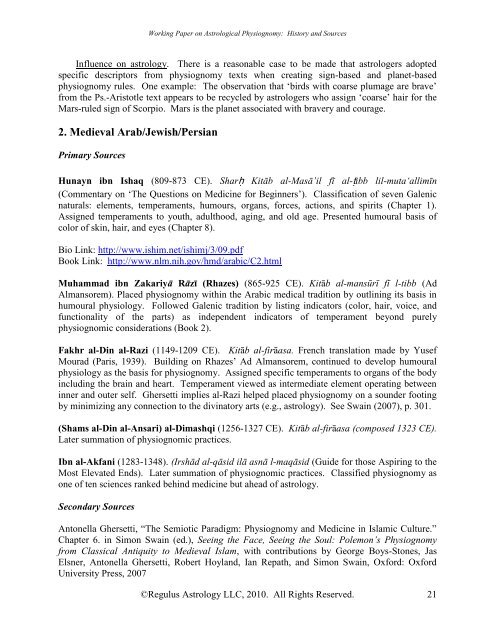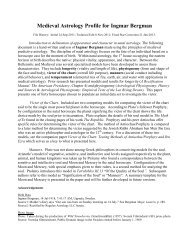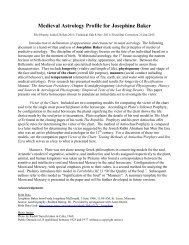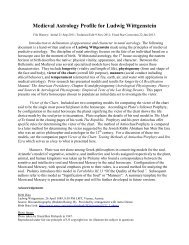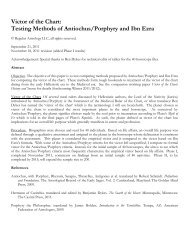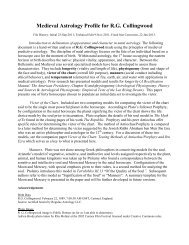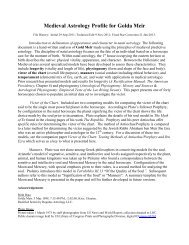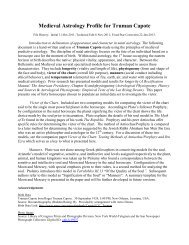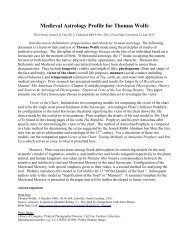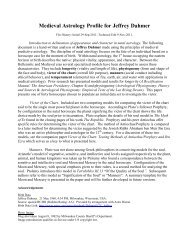Working Paper on Astrological Physiognomy: History and Sources
Working Paper on Astrological Physiognomy: History and Sources
Working Paper on Astrological Physiognomy: History and Sources
Create successful ePaper yourself
Turn your PDF publications into a flip-book with our unique Google optimized e-Paper software.
<str<strong>on</strong>g>Working</str<strong>on</strong>g> <str<strong>on</strong>g>Paper</str<strong>on</strong>g> <strong>on</strong> <strong>Astrological</strong> <strong>Physiognomy</strong>: <strong>History</strong> <strong>and</strong> <strong>Sources</strong><br />
Influence <strong>on</strong> astrology. There is a reas<strong>on</strong>able case to be made that astrologers adopted<br />
specific descriptors from physiognomy texts when creating sign-based <strong>and</strong> planet-based<br />
physiognomy rules. One example: The observati<strong>on</strong> that ‘birds with coarse plumage are brave’<br />
from the Ps.-Aristotle text appears to be recycled by astrologers who assign ‘coarse’ hair for the<br />
Mars-ruled sign of Scorpio. Mars is the planet associated with bravery <strong>and</strong> courage.<br />
2. Medieval Arab/Jewish/Persian<br />
Primary <strong>Sources</strong><br />
Hunayn ibn Ishaq (809-873 CE). Sharḥ Kitāb al-Masā’il fī al-ṭibb lil-muta‘allimīn<br />
(Commentary <strong>on</strong> ‘The Questi<strong>on</strong>s <strong>on</strong> Medicine for Beginners’). Classificati<strong>on</strong> of seven Galenic<br />
naturals: elements, temperaments, humours, organs, forces, acti<strong>on</strong>s, <strong>and</strong> spirits (Chapter 1).<br />
Assigned temperaments to youth, adulthood, aging, <strong>and</strong> old age. Presented humoural basis of<br />
color of skin, hair, <strong>and</strong> eyes (Chapter 8).<br />
Bio Link: http://www.ishim.net/ishimj/3/09.pdf<br />
Book Link: http://www.nlm.nih.gov/hmd/arabic/C2.html<br />
Muhammad ibn Zakariyā Rāzī (Rhazes) (865-925 CE). Kitāb al-mansūrī fī l-tibb (Ad<br />
Almansorem). Placed physiognomy within the Arabic medical traditi<strong>on</strong> by outlining its basis in<br />
humoural physiology. Followed Galenic traditi<strong>on</strong> by listing indicators (color, hair, voice, <strong>and</strong><br />
functi<strong>on</strong>ality of the parts) as independent indicators of temperament bey<strong>on</strong>d purely<br />
physiognomic c<strong>on</strong>siderati<strong>on</strong>s (Book 2).<br />
Fakhr al-Din al-Razi (1149-1209 CE). Kitāb al-firāasa. French translati<strong>on</strong> made by Yusef<br />
Mourad (Paris, 1939). Building <strong>on</strong> Rhazes’ Ad Almansorem, c<strong>on</strong>tinued to develop humoural<br />
physiology as the basis for physiognomy. Assigned specific temperaments to organs of the body<br />
including the brain <strong>and</strong> heart. Temperament viewed as intermediate element operating between<br />
inner <strong>and</strong> outer self. Ghersetti implies al-Razi helped placed physiognomy <strong>on</strong> a sounder footing<br />
by minimizing any c<strong>on</strong>necti<strong>on</strong> to the divinatory arts (e.g., astrology). See Swain (2007), p. 301.<br />
(Shams al-Din al-Ansari) al-Dimashqi (1256-1327 CE). Kitāb al-firāasa (composed 1323 CE).<br />
Later summati<strong>on</strong> of physiognomic practices.<br />
Ibn al-Akfani (1283-1348). (Irshād al-qāsid ilā asnā l-maqāsid (Guide for those Aspiring to the<br />
Most Elevated Ends). Later summati<strong>on</strong> of physiognomic practices. Classified physiognomy as<br />
<strong>on</strong>e of ten sciences ranked behind medicine but ahead of astrology.<br />
Sec<strong>on</strong>dary <strong>Sources</strong><br />
Ant<strong>on</strong>ella Ghersetti, “The Semiotic Paradigm: <strong>Physiognomy</strong> <strong>and</strong> Medicine in Islamic Culture.”<br />
Chapter 6. in Sim<strong>on</strong> Swain (ed.), Seeing the Face, Seeing the Soul: Polem<strong>on</strong>’s <strong>Physiognomy</strong><br />
from Classical Antiquity to Medieval Islam, with c<strong>on</strong>tributi<strong>on</strong>s by George Boys-St<strong>on</strong>es, Jas<br />
Elsner, Ant<strong>on</strong>ella Ghersetti, Robert Hoyl<strong>and</strong>, Ian Repath, <strong>and</strong> Sim<strong>on</strong> Swain, Oxford: Oxford<br />
University Press, 2007<br />
©Regulus Astrology LLC, 2010. All Rights Reserved.<br />
21


